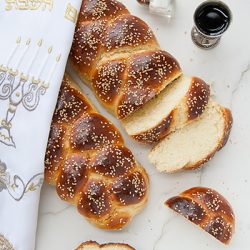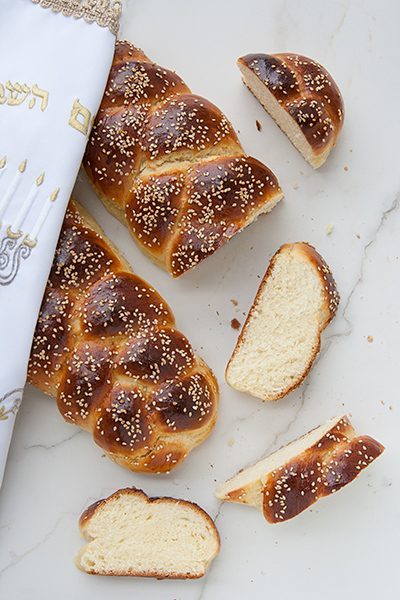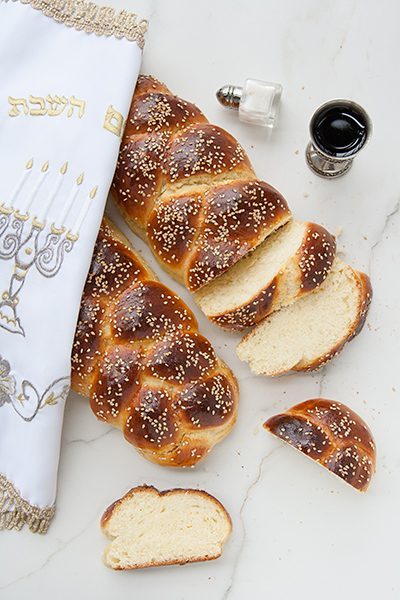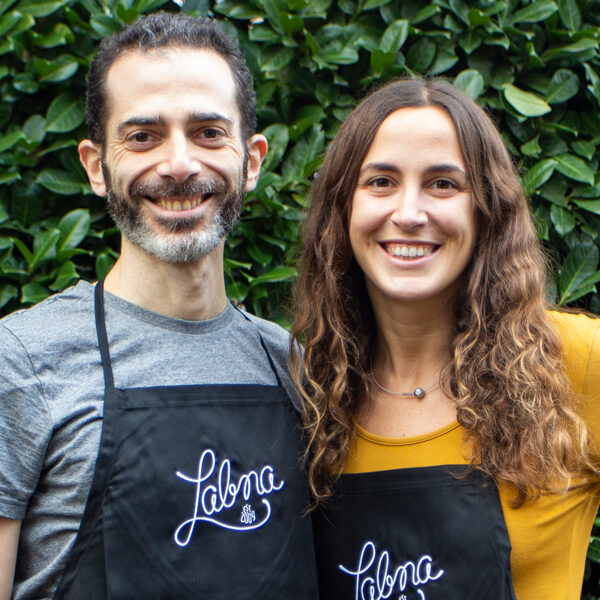Challah – Jewish Shabbat bread
Challah is the traditional Jewish bread we prepare for Shabbat, that is, Friday night, a very special time of the week for us Jews. At the beginning of Shabbat, just after sunset, Jews recite a prayer, called Kiddush, to give thanks to God for the creation of the world; during the Kiddush, wine and challah bread are blessed by the head of the household and distributed among the diners.
If you have never had challah, you are in for a life-changing treat. Challah is similar to pain brioche, but it’s a little less sweet and more compact. It’s delicious on its own, it makes great sandwiches (2023 update: I own a cafè in LA and all we sell is challah sandos, so trust me!), and a few days later it also turns into the best French toast, if you haven’t eaten it all on the first or second day. It’s badly addictive so don’t say I didn’t alert you when you’ll find yourself craving this irresistible bread once (or twice!) a week, ok?

Challah
Ingredients
- 4 cups warm water
- 2 packets active dry yeast
- 1 cup sunflower or canola oil
- 1 cup sugar
- 2 eggs
- 2 tbsp salt
- 4.4 pounds bread flour (all-purpose works ok too)
- 1 egg, for brushing
- sesame or poppy seeds
Instructions
- Dissolve the yeast in a large bowl with warm water (not boiling!) and let it rest a few minutes to activate the yeast,2 packets active dry yeast, 4 cups warm water
- Add sugar, oil, salt, and eggs to the bowl, and mix everything with a spoon. You can also do this in a food processor if you have one, but by hand works just fine.1 cup sunflower or canola oil, 1 cup sugar, 2 tbsp salt, 2 eggs
- Add the flour, but slowly, two cups at a time, because you might end up needing a little more or a little less, depending on humidity, temperature, flour quality, and many other unpredictable factors.
- When the dough comes together and no longer sticks to your hands, knead it well on a floured surface for ten minutes (the longer the better), then transfer it to a lightly greased bowl and let it rise for at least one hour (even two, if you have time) covered with a damp towel, until it doubles in volume.
- Once the mixture is well leavened, shape it (and if you do the hafrashat – I am talking to Jewish readers! – remember to take the part of dough required!). A simple braid with three rolls, like braided hair, is easily accomplished, looks great, and with this mixture if you can make 8.
- Put the bread braids on baking pans covered with parchment paper, allow them to leaven for another half an hour.
- Once fully leavened, brush the challot with 2 yolks diluted in a little water, and sprinkle with sesame or poppy seeds, then bake in a preheated oven at 200°.
- Cook the challot at 200° for about 10 minutes, then reduce the temperature to 180° and bake for another 20 minutes.
- The baking time depends on the oven (about 25/30 minutes, usually), but you will quickly notice if the challah is cooked: the surface will turn a nice color, between brown and golden, releasing a sweet aroma that would be noticed by even the most careless cooks ...
Traditionally, challah is covered during Kiddush and the blessing with a finely embroidered cloth; when the blessing ends, the head of the family breaks one of the challot into small parts, sprinkles a little salt on it, and offers it to the table guests. However, challah is a bread that is suitable for every occasion, whether to accompany your meals or for a snack. Like, if you have Nutella at hand, or peanut butter and jam, to spread all over the bread, you don’t need to wait for Shabbat to bake challah and eat it, ok? Just go for it now!
Keeping gluten-free and looking for a challah recipe? Don’t worry, I got you covered. I have a delicious gluten-free challah recipe you can try – it’s not exactly the same as the real thing, but it’s pretty damn close, so I think you’ll like it.
P.S. Beware of those who use butter in this recipe instead of oil, or even worse, milk, or yogurt! No Jew would ever do that, because it is forbidden to mix dairy products with meat, and on Shabbat, any Jewish family (unless they are vegetarian, I guess?) definitely eats meat!






Lovely recipe!
But I cannot let your final comment go unanswered. While challah should definitely be made with oil in order to keep kosher when consuming meat, there’s nothing wrong with using butter if you’ll eat it with pareve foods – and your last line is simply not correct. Not every Jewish family will have meat for Shabbat. It is definitely the most common food, but many would rather prefer a good fish for Shabbat, and there are even Jewish vegetarians who would certainly not eat flesh meat on Shabbat or any other day.
Hi. I just signed up to receive your blog and need to be sure that it comes to me in English.
I also just finished Lisa Scottolini’s book “Eternal” which is about the Jews of Rome during the second world war. I am in the process of ordering your book.
Thank you.
Toby Colton
Hello! We just moved to Italy and I tried adapting my American recipe with Italian ingredients, and it completely fell apart during the second rise. Do you have a suggestion for the best flour to use?